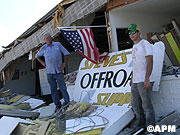Audio
More from MPR
| |||||||||||||||||||||||||
St. Paul, Minn. — There are still a lot of unanswered questions about the expected influx of hurricane evacuees. State Education Commissioner Alice Seagren says she's estimating about 1,000 school-age kids will be among the groups headed to Minnesota this week. And with little else to go on, her department is trying to make plans.
"We don't know what their age range is going to be, so we're going to kind of wait and see if we can find out and figure out what to do," Seagren says. "But we're going to start assembling some school kits for the kids, get those ready."
Seagren is also working with statewide education organizations to try to assess the potential needs of the evacuated children.
Charles Kyte of the Minnesota Association of School Administrators says he notified every school district leader in the state to be ready.
"We're already getting responses from superintendents across the state telling us that they can take a number of students, or that housing is available, or that churches are starting to mobilize," Kyte says. "We're also going to try to work a little closer with the school districts right around the Camp Ripley area, as they will probably be impacted the most."
The evacuees coming to Minnesota will stay in 20 dormitories at Camp Ripley, the National Guard training facility located north of Little Falls. But state officials say that's only a temporary home. The goal is to get them moved into homes around the state as quickly as possible. That means the Twin Cities metro area is a likely destination.
Scott Croonquist of the Association of Metropolitan School Districts says many of the displaced students could end up in Minneapolis, St. Paul and the first-ring suburbs.
"They have affordable housing, and they just might be more attractive for refugees from the standpoint that they are already diverse communities, and so the students might be more comfortable enrolling in some of those schools," Croonquist says. "Our districts will be very much on their toes and looking for direction from the state, and trying to stay abreast of what the plans are."
Rolling out the welcome mat for displaced students is not a matter of altruism. It's a legal requirement. Commissioner Seagren says these students are classified under federal law as homeless, and must be enrolled wherever they show up. She says education officials from the students' home states are trying make the transition a bit easier.
"We just got an e-mail from Louisiana's commissioner, saying that they are going to be working with states, getting their records to our states as soon as they can," Seagren says. "So, we've got a lot of those kind of logistical issues, but our schools have to take the children if they come to their doors."
One potential problem for Minnesota schools is the Oct. 15 deadline for official enrollment counts. Students who show up after that date don't generate any per-pupil state aid, leaving districts short of funds. Seagren says the Legislature could decide to address that issue next year. The state is also seeking federal funding to help offset some of the costs of its relief effort.




